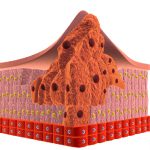Skin cancer can develop in any part of the body, but most often it is developed on skin that is more exposed to the UV radiation. Skin cancer occurs to people of all skin tones. Read more about skin cancer here.
How radiation therapy works for skin cancer?
In radiation therapy, high energy X rays to destroy the cancerous cells. Radiation is given to the patients under strict monitored doses to control the growth of the cancerous cells. It is often given before/after surgeries or in combination with chemotherapy. The main benefit of this treatment is that is does not just kill the cancer cells but also helps in reducing pain and other symptoms of the cancer.
How is radiation therapy given?
If the radiation is externally given, a machine called the linear accelerator is used, whereas in brachytherapy a radioactive isotope is placed in the patient’s body when the radiation is given internally.
In treating skin cancers, radiation is given both externally and internally depending on the patient’s requirement.
When is radiation therapy given?
Radiation therapy is used for skin cancers that are at a higher risk of spreading. It is recommended to given for the following cases:
- As the main treatment to kill the malignant cells
- In combination with other treatments to cure cancer
- Prior other treatments, to shrink the tumour
- After other anticancer treatments to avoid recurrent cancers
- As a part of palliative care to relieve symptoms for advanced skin cancers
Types of radiation therapy:
Radiation to treat the skin cancer cells aims mainly at the affected areas along with the surrounding lymph nodes. Following are the types of radiotherapy therapies used for treating skin cancer:
External beam radiation therapy (EBRT):
This procedure aims at killing the cancerous tissues in the body. EBRT is carried out by directing a beam of radiation externally using a X-ray machine called the linear accelerator. Radiation is mainly used in shrinking tumours. During the treatment, beams of radiation on the areas where there is a presence of tumours or cancer cells are projected by the linear accelerator.
The person is allowed to lay on a table, around which it moves around to deliver the radiation in all possible angles and directions. Higher and more accurate dosage of the radiation in a particular area which helps in avoiding the damage of the other organs. This procedure is one of the safest and painless treatments for treating skin cancer. It is an outpatient procedure and does not harm any of the people around the patient.
Intensity modulated radiation therapy (IMRT):
IMRT is a treatment used for recurring skin cancer, which includes the projection of radiation externally using the linear accelerator. But here, the accelerator delivers radiation in angles and directions that actually match the 3D geometrical shape of the tumour.
Accurate and high doses of radiation are given to the patients who have not been completely cured with lower doses. The advantage of this treatment is that because of precision accuracy.
For patients who haven’t responded for lower doses, accurate and higher doses are given. The major advantage of IMRT is its precision accuracy which means that it projects radiation to the required affected areas and the surrounding healthy cells are not exposed to the radiation.
Tomotherapy:
This treatment involves a machine which is a combination of intensity modulated radiation therapy (IMRT) and the computed tomography (CT) scan. This highly advanced machine can help deliver radiation to tumours with complex shapes. The CT scan confirms the size, shape and position of the tumour and tomotherapy reduces the exposure to healthy tissues and organs.
Side effects of Radiotherapy:
The damage of the healthy blood cells in the body, when the radiation is given in high doses leads to side effects. These might have adverse effects on the body. The short term side effects go away after one to two weeks of treatment, but the patient has to deal with the long term side effects for considerably very long time. On noticing any adverse side effects, doctors have to consulted immediately. Side effects of radiotherapy in treating skin cancer could be:
- Skin problems, especially Sunburns
- Skin tone changes
- Hair loss
- Fatigue
- Nausea
- Memory loss
- Headaches
- Reduced sexual desire
- Damage to saliva
- Heart problems
Read more about after treatment of radiotherapy for skin cancer here.
Outlook:
The dosage of the radiation given to the patients depends on the type and stage of skin cancer along with the medical history and tolerance levels of the patients. Radiotherapy has a good survival rate for treating skin cancer. Increasing the dosage of radiation and giving it the right way without majorly affecting other parts of the body increases the survival rate of radiation therapy for skin cancer.




